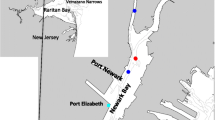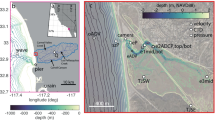Abstract
The tidal dynamics in a pristine, mesotidal (>2 m range), marsh-dominated estuary are examined using moored and moving vessel field observations. Analysis focuses on the structure of the M 2 tide that accounts for approximately 80% of the observed tidal energy, and indicates a transition in character from a near standing wave on the continental shelf to a more progressive wave within the estuary. A slight maximum in water level (WL) occurs in the estuary 10–20 km from the mouth. M 2 WL amplitude decreases at 0.015 m/km landward of this point, implying head of tide approximately 75 km from the mouth. In contrast, tidal currents in the main channel 25 km inland are twice those at the estuary mouth. Analysis suggests the tidal character is consistent with a strongly convergent estuarine geometry controlling the tidal response in the estuary. First harmonic (M 4) current amplitude follows the M 2 WL distribution, peaking at mid-estuary, whereas M 4 WL is greatest farther inland. The major axis current amplitude is strongly influenced by local bathymetry and topography. On most bends a momentum core shifts from the inside to outside of the bend moving seaward, similar to that seen in unidirectional river flow but with point bars shifted seaward of the bends. Dissipation rate estimates, based on changes in energy flux, are 0.18–1.65 W m−2 or 40–175 μW kg–1. A strong (0.1 m/s), depth-averaged residual flow is produced at the bends, which resembles flow around headlands, forming counter-rotating eddies that meet at the apex of the bends. A large sub-basin in the estuary exhibits remarkably different tidal characteristics and may be resonant at a harmonic of the M 2 tide.












Similar content being viewed by others
References
Aubrey DG, Speer PE (2004) A study of nonlinear tidal propagation in shallow inlet-estuarine systems. Part I. Observations. Estuar Coast Shelf Sci 21:185–205
Blanton J (1969) Energy dissipation in a tidal estuary. J Geophys Res 74:5460–5466
Blanton J, Alber M, Sheldon J (2001) Salinity response of the Satilla River estuary to seasonal changes in freshwater discharge. In: Hatcher KJ (ed) Proceedings of the 2001 Georgia water resources conference. Institute of Ecology, The University of Georgia, Athens, Georgia, pp 1–4
Blanton J, Lin G, Elston S (2002) Tidal current asymmetry in shallow estuaries and tidal creeks. Cont Shelf Res 22:1731–1743
Blanton B, Werner F, Seim H, Luettich RA Jr, Lynch D, Smith K, Voulgaris G, Bingham F, Way F (2004) Barotropic tides in the South Atlantic Bight. J Geophys Res 109(C12024):1–17. DOI:10.1029/2004JC002455
Dame R, Alber M, Allen D, Mallin M, Montague C, Lewitus A, Chalmers A, Gardner R, Gilman C, Kjerfve B, Pickney J, Smith N (2000) Estuaries of the South Atlantic Coast of North America: their geographical signatures. Estuaries 23:793–819
Friedrichs C, Aubrey D (1988) Non-linear tidal distortion in shallow well-mixed estuaries: a synthesis. Estuar Coast Shelf Sci 27:521–545
Friedrichs C, Aubrey D (1994) Tidal propagation in strongly convergent channels. J Geophys Res 99:3321–3336
Geyer RW (1993) Three-dimensional tidal flow around headlands. J Geophys Res 98:955–966
Geyer RW, Signell P (1990) Measurement of tidal flow around a headland with a shipboard acoustic Doppler current profiler. J Geophys Res 95:3189–3198
Geyer RW, Trowbridge JH, Bowen MM (2000) The dynamics of a partially mixed estuary. J Phys Oceanogr 30:2035–2048
Harleman DRF (1966) Tidal dynamics in estuaries: real estuaries. Estuary and coastline hydrodynamics. In: Ippen AT (ed) McGraw-Hill, New York, pp 522–545
Ianniello JP (1977) Tidally induced residual currents in estuaries of constant breadth and depth. J Mar Res 35:755–786
Ianniello JP (1979) Tidally induced residual currents in estuaries of variable breadth and depth. J Phys Oceanogr 9(5):962–974
Ippen AT (1966) Tidal dynamics in estuaries: estuaries of rectangular section. Estuary and coastline hydrodynamics. In: Ippen AT (ed) McGraw-Hill, New York, pp 493–522
Jay DA (1991) Green’s law revisited: tidal long-wave propagation in channels with strong topography. J Geophys Res 96(20):585–598
Kjerfve B (1978) Bathymetry as an indicator of net circulation in well-mixed estuaries. Limnol Oceanogr 23:816–821
Kjerfve B, Knoppers BA (1991) Tidal choking in a coastal lagoon. Tidal Hydrodynamics. In: Parker B (ed) Wiley, New York, pp 169–181
Kjerfve B, Proehl JA (1979) Velocity variability in a cross-section of a well-mixed estuary. J Mar Res 37:409–418
Lanzoni S, Seminara G (1998) On tide propagation in convergent estuaries. J Geophys Res 103(30):793–812
Lavelle JB, Mojfeld HO, Lempriere-Doggett E, Cannon GA, Pashinski DJ, Cokelet ED, Lytle L, Gill S (1988) A multiply-connected channel model of tides and tidal currents in Puget Sound, Washington and a comparison with updated observations. NOAA Technical Memorandum ERL PMEL-84, 103 pp
Li C, O’Donnell J (1997) Tidal induced residual circulation in estuaries with lateral depth variation. J Geophys Res 102(27):915–929
Parker BB (1991) The relative importance of the various nonlinear mechanisms in a wide range of tidal interactions (review). In: Parker BB (ed) Tidal hydrodynamics. Wiley, New York, pp 237–268
Pawlowicz R, Beardsley B, Lentz S (2002) Classical tidal harmonic analysis including error estimates in MATLAB using T_TIDE. Comput Geosci 28:929–937
Peters H (2003) Broadly distributed and locally enhanced turbulent mixing in a tidal estuary. J Phys Oceanogr 33:1967–1977
Prandle D (2003) Relationships between tidal dynamics and bathymetry in strongly convergent estuaries. J Phys Oceanogr 33:2738–2750
Pugh D (1987) Tides, surges and mean sea-level: a handbook for engineers and scientists. Wiley, Chichester, UK
Seim H, Gregg MC (1997) The importance of aspiration and channel curvature in producing strong vertical mixing at a sill. J Geophys Res 102:3451–3472
Seim H, Blanton J, Gross T (2002) Direct stress measurements in a shallow sinuous estuary. Cont Shelf Res 22:1565–1578
Sexton WJ, Hayes MO (1996) Holocene deposits of reservoir-quality sand along the central South Carolina coastline. AAPG Bull 80(6):831–855
Simpson JH, Fischer NR, Wiles P (2004) Reynolds stress and TKE production in an estuary with a tidal bore. Estuar Coast Shelf Sci 60:619–627
Smith JD, McLean SR (1984) A model for flow in meandering streams. Water Resour Res 20(9):1301–1315
Speer PE, Aubrey DG (1985) A study of nonlinear tidal propagation in shallow inlet-estuarine systems. Part II. Theory. Estuar Coast Shelf Sci 21:207–224
Taylor G (1919) Tidal friction in the Irish Sea. Philos Trans R Soc Lond A 220:1–93
Uncles RJ, Kjerfve B (1986) Transverse structure of residual flow in North Inlet, South Carolina. Estuaries 9:39–42
UNESCO (1985) The international system of units (SI) in oceanography. UNESCO Technical Papers No. 45. IAPSO Publication Science No. 32, Paris, France
USGS (2004) Published daily mean stream flow data for Station 02228000, Satilla River at Atkinson, Georgia. National Water Information System, http://waterdata.usgs.gov/nwis
Acknowledgements
We wish to thank several people who made indispensable contributions to this study. Julie Amft, Cheryl Burden Ross, Trent Moore, and Guoqing Lin played critical roles in the design, planning, and execution of the field program; it could not have happened without them. Anna Boyette at Skidaway Institute of Oceanography contributed to the preparation of the figures. The crew of the R/V BLUE FIN (Captain Jay Fripp, Raymond Sweatte, and Mike Richter) of the Skidaway Institute of Oceanography gave us dedicated enthusiasm and support in carrying out the field experiments. We also thank two anonymous reviewers for their thoughtful comments.
We gratefully acknowledge the following agencies who supported the work described in this paper: the Georgia Coastal Zone Management Program (Grant No. RR100-279/9262764), National Science Foundation (LMER Grant No. DEB-9412089 and LTER Grant No. OCE-9982133), NOAA Coastal Ocean Program (Grant to South Carolina Sea Grant Consortium entitled “Tidal Circulation and Salt Transport in a Tidal Creek–Salt Marsh Complex”), and the Office of Naval Research (the SEACOOS program, N00014-02-1-0972).
Author information
Authors and Affiliations
Corresponding author
Additional information
Responsible editor: Paulo Salles
Rights and permissions
About this article
Cite this article
Seim, H., Blanton, J. & Elston, S. Tidal circulation and energy dissipation in a shallow, sinuous estuary. Ocean Dynamics 56, 360–375 (2006). https://doi.org/10.1007/s10236-006-0078-x
Received:
Accepted:
Published:
Issue Date:
DOI: https://doi.org/10.1007/s10236-006-0078-x




